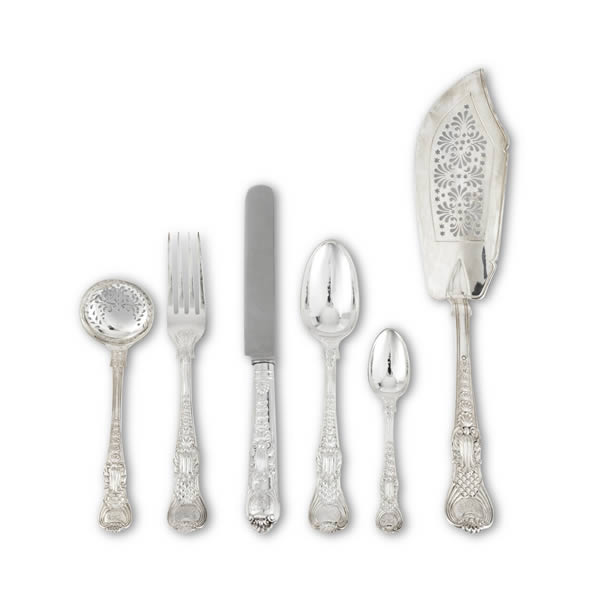Silverware Restoration in London
Preserving Functionality and Elegance
Silverware, including forks, knives, spoons, serving utensils, serving dishes, platters and gravy boats, has long been a symbol of sophistication at dining tables around the world. Whether part of an heirloom set or a modern collection, these functional yet elegant items require maintenance to preserve their beauty and functionality. Over time, silverware may experience tarnishing, scratches, and wear, but with the proper care and restoration, it can be returned to its original state, ready for use or display.


Why Invest in Silverware Restoration?
Restoring silverware is an investment in both its beauty and functionality. Whether it is a set of forks, knives, spoons, or serving utensils, well-maintained silverware adds elegance to any dining occasion. For antique or heirloom pieces, restoration ensures that the sentimental or financial value is preserved. Silverware restoration is about more than just cleaning—it’s about ensuring these functional, decorative pieces continue to serve their purpose while remaining beautiful for years to come.
By restoring your silverware, you not only enhance its aesthetic appeal but also protect its long-term durability, ensuring it remains a treasured part of your table for generations.
When to Seek Professional Restoration
While minor tarnish removal and cleaning can often be done at home, professional restoration is recommended for silverware with significant issues, such as deep scratches, extensive tarnish, or loss of silver plating. A professional restorer has the necessary tools and expertise to restore the silverware’s full beauty without causing further damage.
Common Issues with Silverware
Silverware faces several common issues that can detract from its appearance and functionality:
- Tarnishing: Silver naturally tarnishes when exposed to air and moisture, causing it to lose its shiny appearance.
- Scratches: Frequent use, improper storage, or contact with abrasive materials can result in surface scratches, which are especially noticeable on polished silverware.
- Dents and Dings: Silverware, particularly utensils like forks and spoons, can get bent or damaged through accidental drops or improper handling.
- Plating Wear: Silver-plated utensils can lose their thin silver coating over time, revealing the base metal beneath, which can affect the appearance.
- Discolouration: Exposure to food acids or cleaning agents can lead to discoloration on the surface of silverware.
- Loose Handles or Joints: For some silverware, such as serving utensils with detachable handles, the handles may become loose or damaged.
Why is Silverware Restoration Important?
Restoring silverware is important for several reasons:
- Aesthetic Appeal: Restoring tarnished or scratched silverware helps bring back its luster and ensures it continues to shine with elegance.
- Functionality: Proper restoration can fix functional issues like loose joints or handles, making the silverware safe and effective for use at the dining table.
- Preservation: Timely restoration helps prevent further damage, preserving the silverware’s beauty and longevity.
- Sentimental or Collectible Value: Many pieces of silverware, particularly antique or heirloom items, hold sentimental value. Restoration ensures that these items continue to be treasured for generations.
The Process of Restoring Silverware
Restoring silverware requires a delicate balance between careful cleaning and repair. The process typically involves the following steps:
1. Inspection and Assessment
The first step in restoring silverware is a thorough inspection. This includes assessing the degree of tarnish, scratches, dents, and wear. Any functional issues, such as loose handles or joints, are also identified during this stage.
2. Cleaning the Surface
A gentle cleaning is performed to remove dirt, grime, and tarnish. Mild soap and water are often sufficient for cleaning the surface of silverware. For more intricate pieces or severe tarnishing, specialized silver polish or natural cleaning solutions, like a baking soda paste, may be used.
3. Tarnish Removal
The most common issue with silverware is tarnishing. A silver polish or tarnish remover is applied to restore the metal’s original brilliance. For silver-plated utensils, great care is taken to avoid polishing too aggressively, which could lead to further plating loss.
4. Repairing Scratches, Dents, and Dings
Minor scratches and dents are gently buffed or worked out, often using specialized tools. For silverware with heavy damage, such as deep gouges or large dents, more intensive repair techniques may be required to reshape the piece and restore its original form.
5. Replating (If Necessary)
If silver-plated utensils show signs of wear, a new layer of silver may be applied through electroplating. This process restores the piece’s appearance and provides protection against future tarnishing.
6. Polishing and Finishing
Once cleaning and repairs are completed, the silverware is polished to a high shine. For more intricate designs or engravings, extra care is taken to preserve the detail. A protective coating may also be applied to help resist tarnishing in the future.
Maintaining Restored Silverware
Proper maintenance is essential to keeping restored silverware in top condition. Here are some tips to maintain its beauty and functionality:
- Regular Cleaning: After each use, clean silverware with a soft cloth to remove food particles, moisture, and fingerprints.
- Avoid Harsh Cleaners: Refrain from using abrasive or harsh cleaning products that could scratch the surface or wear down the silver plating.
- Proper Storage: Store silverware in a dry, tarnish-resistant pouch or cloth to protect it from exposure to moisture and air.
- Handle with Care: Avoid dropping or mishandling silverware to prevent dents, scratches, or bending. Use a soft cloth or gloves when handling to avoid leaving fingerprints.
Silver Repairs, Restoration & Silver Plating by post
Send us your silver for restoration, repairs or silver plating with ease! Simply click the button below to download our "Send by Post" Repair Form. Complete the form and mail your silver item to us. Once repaired, your item will be returned to you securely via Special Delivery.
Let us handle your silver with the care it deserves, no matter where you are!

